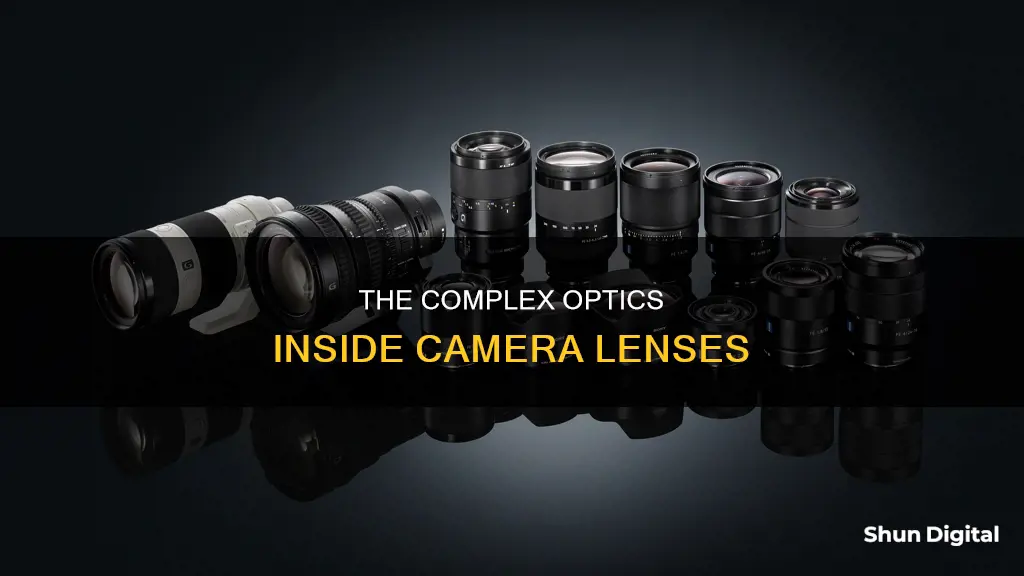
Camera lenses are an essential component of photography, capturing light and focusing it onto a sensor to create images. The lens is the most important part of a camera, and its quality can make or break a photograph. All but the simplest cameras contain lenses that are made up of several lens elements, each of which has a specific purpose and arrangement. These lens elements work together to direct the path of light rays to accurately recreate the image on the digital sensor. The number of lens elements can vary from one, like in the Box Brownie's meniscus lens, to over 20 in the more complex zooms. In this article, we will explore why camera lenses have so many optics and how this impacts image quality.
| Characteristics | Values |
|---|---|
| Number of optics | Depends on the camera's complexity, ranging from a single element to over 20 in the most complex zooms |
| Purpose of multiple optics | To direct the path of light rays to accurately recreate the image on the digital sensor and to minimize aberrations |
| Optical aberrations | Occur when points in the image do not translate back to single points after passing through the lens, causing blurring, reduced contrast or misalignment of colors |
| Aperture size | The size of the aperture controls the amount of light entering the lens; lenses with wider apertures require larger front elements |
| Focal length | Determines the angle of view and the magnification of the image; longer focal lengths require longer physical lenses |
What You'll Learn

Optical design complexity
The complexity of a camera lens's optical design is a primary reason for their often large size. A camera lens is not a simple, single-element piece of glass; instead, it is a sophisticated assembly of multiple lens elements, each with a specific purpose and arrangement. The number and configuration of these lens elements are critical in determining the overall size of the lens.
More complex optical designs, such as those found in zoom lenses, require a greater number of lens elements to achieve the desired image quality, aberration correction, and focal length range. These additional lens elements significantly contribute to the overall size and weight of the lens. For example, a basic prime lens may have as few as 5-6 lens elements, while a high-end zoom lens can have upwards of 15-20 elements. The optical design's complexity directly influences the size of the lens, as more elements require a larger lens body to accommodate them.
The goal of using multiple lens elements is to minimise optical aberrations while utilising the fewest and least expensive elements. Optical aberrations occur when points in the image do not translate back to single points after passing through the lens, causing issues like image blurring, reduced contrast, or misalignment of colours (chromatic aberration). By using multiple lens elements, designers can reduce these aberrations and improve image quality.
The front element of the lens is critical to the performance of the entire assembly. Its curvature is usually set to minimise aberration, and in a prime lens, this is easily achieved, but in a zoom lens, there is always a compromise. The front element's size is directly related to the maximum aperture of the lens, with wider apertures requiring larger front elements to allow more light to pass through. This, in turn, affects the size of the lens barrel needed to house the assembly.
The complexity of the optical design also depends on various factors such as the angle of view, the maximum aperture, and the intended price point. An extreme wide-angle lens with a large aperture, for instance, requires a very complex construction to correct for optical aberrations, which are more pronounced at the edge of the field and when using the edge of a large lens for image-forming. On the other hand, a long-focus lens with a small aperture can attain similar image quality with a much simpler design, sometimes requiring only a doublet (two elements).
Understanding Camera Lenses: Capturing Perfect Shots with Different MM Lenses
You may want to see also

Aperture size
Aperture refers to the opening in a lens that allows light to enter the camera. It is often compared to the pupil of the human eye, which adjusts in size to control the amount of light entering the eye. Similarly, the aperture in a camera lens can be adjusted to control the amount of light that reaches the film or image sensor. This adjustment is typically made using a diaphragm, a mechanical component consisting of overlapping blades that can expand or contract to change the size of the opening.
The size of the aperture is measured in f-numbers or f-stops, which are ratios of the lens's focal length to the diameter of the aperture. For example, an aperture of f/2 means the diameter of the opening is half the focal length. It's important to note that smaller f-numbers represent larger apertures, allowing more light to enter the camera.
The Impact of Aperture Size on Exposure
In addition to exposure, aperture size also affects the depth of field in your photographs. Depth of field refers to the zone of sharp focus in an image, from the nearest to the farthest objects that appear in focus. A larger aperture, such as f/1.4, creates a shallow depth of field, resulting in a blurry background and sharp focus on the subject. This technique is commonly used in portrait photography to isolate the subject from the background. On the other hand, a smaller aperture, such as f/16, results in a deeper depth of field, keeping both the foreground and background in focus. Landscape photographers often use this technique to ensure that everything in the image is sharp.
The Sweet Spot of Aperture
While a wider aperture allows for more light and a shallower depth of field, it's important to consider the impact of lens aberrations and diffraction. Lens aberrations refer to imperfections in the lens that can cause blurring, reduced contrast, or chromatic aberration (misalignment of colors). These aberrations are typically more pronounced at wider apertures. Diffraction, on the other hand, is a phenomenon where light waves bend as they pass through a small opening, causing a loss of sharpness in the image. This effect becomes more noticeable at narrower apertures. Therefore, the "sweet spot" of aperture is usually found in the middle range, such as between f/4 and f/11, where you can achieve optimal sharpness, reduced aberrations, and a manageable depth of field.
Understanding aperture size and its impact on your photographs is essential for improving your photography skills. By adjusting the aperture, you can control the amount of light entering the camera, affecting exposure and depth of field. Additionally, finding the sweet spot of your lens will help you capture sharp images with minimal aberrations. Remember to experiment with different aperture settings to discover the unique effects they create and enhance your creative control over your images.
Why Some Camera Lenses Are So Expensive
You may want to see also

Focal length
A lens with a shorter focal length provides a wider angle of view, capturing more of the scene but making the subject appear smaller. This is ideal for architectural, documentary, and landscape photography, as well as environmental portraiture, large groups, and small spaces. Longer focal lengths, on the other hand, offer a narrower angle of view and more magnification, making them suitable for sports, wildlife, and wedding photography, where the photographer needs to maintain a distance from the subject.
The focal length of a lens also influences the perspective of an image. While perspective is technically determined by the photographer's location relative to the subject, using different focal lengths can result in exaggerated or compressed perspectives. For example, a wide-angle lens will stretch the perspective, while a telephoto lens will flatten it.
When choosing a lens, photographers need to consider the desired focal length for their specific style of photography. Lenses are categorised based on their focal length, with ultra-wide lenses having a focal length of less than 24mm, wide-angle lenses ranging from 24mm to 35mm, standard lenses between 35mm and 70mm, telephoto lenses from 70mm to 300mm, and super-telephoto lenses exceeding 300mm.
Camera Lenses: Do They Age Like Wine or Rust?
You may want to see also

Image stabilisation
Lens Stabilisation
Lens stabilisation works by moving the glass elements within the lens to counteract camera movement. Lenses with this technology use sensors to detect how the camera is moving and adjust their elements accordingly. This is often referred to as optical image stabilisation (OIS).
In-Body Image Stabilisation (IBIS)
IBIS, on the other hand, moves the camera sensor to neutralise any movement within the camera. The key advantage of this system is that if your camera has IBIS, all the lenses you use with it will also have image stabilisation.
Advantages of Lens Stabilisation
- Far more effective with telephoto lenses.
- Performs better in low-light conditions.
- More effective overall.
- Has no effect on your metering and autofocus.
- Offers better battery life.
Advantages of In-Body Stabilisation
- Cheaper in the long run, as it usually results in lower lens prices.
- Universal—it works with all lenses.
- Operates in silence.
- Offers cleaner bokeh.
Disadvantages of Image Stabilisation
The Ugly Truth: Camera Lenses and Distortion
You may want to see also

Specialised features
Specialized Features
Some camera lenses are designed with specialized features that contribute to their larger size and weight. These features include:
Tilt-shift lenses
Tilt-shift lenses, commonly used for architectural and landscape photography, have additional mechanisms that allow the lens to tilt and shift relative to the camera’s image sensor. These complex mechanisms require a larger lens body to accommodate the extra components.
Macro lenses
Macro lenses, designed for close-up photography, often have a longer physical length to achieve the necessary magnification and working distance. The larger lens size is necessary to house the specialized optics required for macro photography.
Professional video and cinema production lenses
Lenses designed for professional video and cinema production can be significantly larger than those used for still photography. This is due to the additional features, such as parfocal zoom (maintaining focus while zooming) and precise manual control, which require more complex optical and mechanical designs.
Unique optical designs
Lenses with unique optical designs, such as fisheye lenses, anamorphic lenses, or reflector/mirror lenses, may also be larger in size to accommodate their specialized optical elements and configurations.
Anti-Fog for Camera Lenses: Cat Crap's Effectiveness
You may want to see also
Frequently asked questions
Camera lenses are made up of multiple optical elements to direct the path of light rays and recreate the image as accurately as possible on the digital sensor.
Each optical element in a camera lens has a specific purpose and arrangement, working together to minimise aberrations and improve image quality.
A higher number of optical elements can help to reduce aberrations and improve image sharpness and clarity. However, it is a careful balance as too many elements can degrade image quality due to the increased number of surfaces for light to pass through.
Yes, a higher number of optical elements can increase the size, weight, and cost of the lens. Additionally, more elements can lead to reduced light transmission and contrast due to light reflection at each interface.
Some specialised features of camera lenses that often require additional optical elements include image stabilisation, tilt-shift mechanisms, macro photography capabilities, and parfocal zoom for video production.







